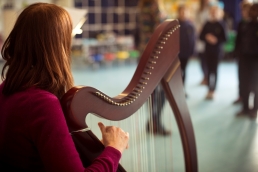
Back to Cerdd Iaith! It’s worth saying that the British Council is passionate about people learning international languages; we recognise the importance of languages in building friendships and empathy between cultures and we believe that young people having the ability to speak and understand international languages is essential to this. We also know that this leads to increased trust, engagement, and trade between and within societies.
And so, with the advent of the new curriculum in Wales, and its stated aim to provide young people with curiosity and enthusiasm, we aim to create the foundations for a lifelong interest in the languages of Wales and the languages of the world. Therefore, we think now is just the right moment to create new Cerdd Iaith activities and to roll these out to as many schools in Wales as possible.
There are four main aspects to language learning, speaking, listening, reading, and writing – these are recognisable to many of you who will be reading! Cerdd Iaith starts with the idea that if you get speaking and listening right, then the motivation to investigate reading and writing will follow. Cerdd Iaith is aimed at upper primary school learners, years five and six, so that learners go into secondary school with a positive and confident approach to learning a new language.
There is something vital in the British Council’s approach and appetite for teaching international languages, coming together with the aims of the new Welsh curriculum, and then using the pillars of creative education to build this resource. Cerdd Iaith is based on encouraging learners to be independent enquirers, creative thinkers, reflective learners, team workers, and effective participants – what’s not to love?!
The Durham Commission on Creativity and Education was convened to look at how our education system and wider system of learning for learners can grow the capacity for creativity. The commission began by asking how creativity is experienced and valued in the world:
‘Creativity, of course, goes by many names. It may be called intuition, enquiry, or expression; for business, it may be described as innovation, invention, or entrepreneurship. In all areas of life, from the sciences and humanities to the arts, creativity is seen as the ability to think laterally and come up with imaginative solutions to problems, to work across disciplines or to enjoy constructive play’.
So how does this relate to language learning in the classroom and in particular, in relation to Cerdd Iaith? To take one example, Cerdd Iaith offers language learning (Spanish and Welsh) in the context of travelling to Patagonia. Learners are asked to think about the voyage of the Welsh settlers to Patagonia on their ship the Mimosa. The teacher asks them to imagine how the settlers would have felt and what they might have seen? Then they ask the learners to ‘become’ a frozen picture of something on the ship. The exercises encourage learners to use vocabulary learnt in a previous exercise while also exploring Welsh culture and history. They speak and hear Welsh and Spanish, while having fun and using their imaginations. In another exercise learners are asked to take it in turns to introduce themselves, and to state what they will be taking in their suitcase. They must then repeat, (remember) all the objects that the learners before them have said, in the right order, before they name their own object. They can create an action or gesture to go with their object which everyone must repeat. This is a memory game with context, one which places language in a real-life scenario. When we set rules for learners, such as those involved in playing a game, they often find it easier to be imaginative and free. The fact they had previously learnt new words and were being asked now to use them in the story, makes it easier and ‘encourages a deeper level of learning.
My next blog will explore some more aspects of the Cerdd Iaith resource, so keep a look out for the next in our series!
